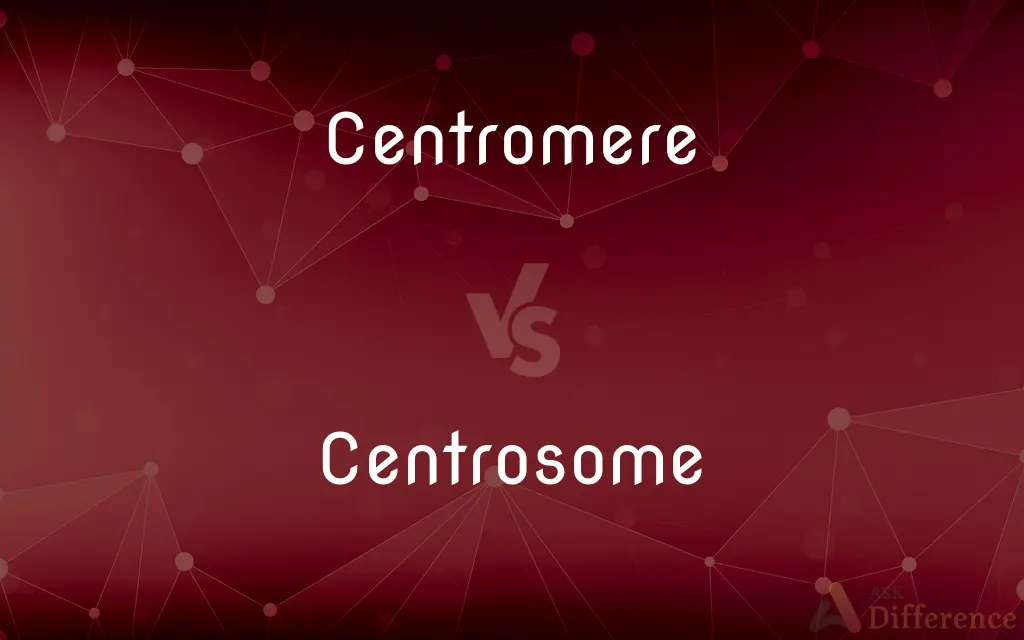Centromere vs. Centrosome — What's the Difference?
Edited by Tayyaba Rehman — By Maham Liaqat — Updated on March 8, 2024
Centromeres are chromosome regions crucial for sister chromatid attachment, while centrosomes are cell organelles that organize microtubules.

Difference Between Centromere and Centrosome
Table of Contents
ADVERTISEMENT
Key Differences
Centromeres are specialized DNA sequences found on chromosomes, playing a key role in the proper segregation of chromosomes during cell division by holding sister chromatids together. On the other hand, centrosomes serve as the main microtubule organizing centers in animal cells, crucial for forming and anchoring the spindle fibers that separate chromosomes during cell division.
Centromeres are characterized by the presence of specific proteins, such as CENP-A, that distinguish them from other DNA regions and are essential for chromosome stability and movement. Whereas centrosomes consist of two centrioles surrounded by a matrix of proteins that are involved in microtubule nucleation and anchoring.
The function of the centromere is primarily to ensure the correct distribution of chromosomes to daughter cells during mitosis and meiosis, thereby maintaining genetic stability. In contrast, the centrosome plays a broader role in cell organization, not only participating in chromosome segregation but also in cell shape, polarity, and motility.
The structure of centromeres can vary widely among different species, and even among different chromosomes within a species, reflecting their adaptability to different chromosomal architectures and segregation mechanisms. Centrosomes, however, have a more conserved structure across species, with variations mainly in the number and arrangement of centrioles.
While the centromere is a critical part of the chromosome structure and its function is tied to the DNA sequence and associated proteins, the centrosome is a separate organelle that interacts with various cell components, including the cytoskeleton and membranes, to orchestrate cell division and organization.
ADVERTISEMENT
Comparison Chart
Definition
Region on a chromosome where sister chromatids attach.
Cell organelle organizing microtubules.
Function
Ensures proper chromosome segregation during cell division.
Organizes spindle fibers for chromosome separation.
Structure
Consists of specific DNA sequences and proteins.
Comprises centrioles and surrounding protein matrix.
Role in Cell Division
Holds sister chromatids together until separation.
Forms spindle apparatus for chromosomal movement.
Variability
Varies in size and sequence across species.
More conserved structure, varies in centriole arrangement.
Compare with Definitions
Centromere
A centromere is a chromosome region ensuring sister chromatids' attachment during cell division.
The centromere's position can affect the shape of the chromosome during cell division.
Centrosome
Centrosomes are involved in cell division, cell polarity, and intracellular transport.
During mitosis, centrosomes help organize the mitotic spindle.
Centromere
It is characterized by unique sequences and proteins, essential for chromosome segregation.
Centromere proteins, like CENP-A, are crucial for its function.
Centrosome
A centrosome is an organelle that organizes microtubules in animal cells.
The centrosome duplicates before cell division to help form the spindle apparatus.
Centromere
Centromeres are pivotal in maintaining genetic stability across generations.
Faulty centromeres can lead to chromosome missegregation and genetic disorders.
Centrosome
It consists of two centrioles surrounded by a matrix of proteins.
Centrosomes play a crucial role in determining cell polarity.
Centromere
The size and sequence of centromeres can vary significantly among organisms.
Yeast centromeres are relatively small, while human centromeres are much larger.
Centrosome
The structure and function of centrosomes are more conserved across species.
Most animal cells contain a pair of centrioles in their centrosome.
Centromere
Their primary role is in cell division, particularly during mitosis and meiosis.
The centromere holds sister chromatids together until anaphase.
Centrosome
They are not directly involved in genetic inheritance but are crucial for proper cell division.
Centrosome dysfunction can lead to abnormal cell division and cancer.
Centromere
The centromere is the specialized DNA sequence of a chromosome that links a pair of sister chromatids (a dyad). During mitosis, spindle fibers attach to the centromere via the kinetochore.
Centrosome
In cell biology, the centrosome (Latin centrum 'center' + Greek sōma 'body') (also called cytocenter) is an organelle that serves as the main microtubule organizing center (MTOC) of the animal cell, as well as a regulator of cell-cycle progression. The centrosome provides structure for the cell.
Centromere
The most condensed and constricted region of a chromosome, to which the spindle fiber is attached during mitosis.
Centrosome
A small region of cytoplasm adjacent to the nucleus that contains the centrioles and serves to organize microtubules.
Centromere
(genetics) The central region of a eukaryotic chromosome where the kinetochore is assembled.
Centrosome
(cytology) An organelle, near the nucleus in the cytoplasm of most organisms, that controls the organization of its microtubules
Centromere
A specialized condensed region of a chromosomes that appears during mitosis where the chromatids are held together to form an X shape.
Centrosome
A peculiar rounded body lying near the nucleus of a cell. It is regarded as the dynamic element by means of which the machinery of cell division is organized.
Centromere
A specialized condensed region of each chromosome that appears during mitosis where the chromatids are held together to form an X shape;
The centromere is difficult to sequence
Centrosome
Small region of cytoplasm adjacent to the nucleus; contains the centrioles and serves to organize the microtubules
Common Curiosities
What happens if the centrosome is absent in a cell?
Cells without centrosomes may still divide, but often with errors in spindle formation, leading to abnormal cell division.
Are centromeres and centrosomes present in all types of cells?
Centromeres are found in all eukaryotic chromosomes, while centrosomes are primarily found in animal cells, with plant and fungal cells having different microtubule organizing centers.
Can the number of centrosomes in a cell change?
Yes, during cell division, the centrosome duplicates to help form the bipolar spindle required for chromosome segregation.
Can a cell function without a centromere?
No, a centromere is crucial for proper chromosome segregation during cell division, and its absence can lead to genetic instability.
Are centrosomes necessary for cytokinesis?
While not directly involved in cytokinesis, centrosomes play a crucial role in organizing the spindle fibers that ensure proper chromosome segregation before cell division.
Can centromeres be artificially altered?
Scientists can manipulate centromere sequences and proteins in research to study their function, but this is complex and not commonly done outside of controlled experiments.
What is the kinetochore, and how is it related to the centromere?
The kinetochore is a protein complex assembled on the centromere, serving as the attachment site for spindle microtubules during cell division.
How do centromeres contribute to chromosome shape?
The position of the centromere on a chromosome affects its shape during cell division, leading to metacentric, submetacentric, acrocentric, and telocentric chromosome forms.
How do centrosomes differ in plant cells?
Plant cells lack centrosomes with centrioles but have microtubule organizing centers that function similarly in cell division.
How do centromeres affect evolutionary processes?
Variations in centromere structure and function can influence chromosome segregation and genetic diversity, impacting evolution.
Can centrosome abnormalities lead to cancer?
Yes, abnormalities in centrosome number or structure can lead to improper cell division, contributing to tumorigenesis and cancer progression.
How are centromeres related to genetic diseases?
Defects in centromere function or structure can lead to chromosome missegregation and aneuploidy, contributing to various genetic disorders and cancers.
Is the centrosome the same as the centriole?
No, the centrosome is an organelle that contains two centrioles in animal cells, but they serve different functions within the centrosome.
How are new centromeres formed?
New centromeres, or neocentromeres, can form at non-traditional chromosome locations through poorly understood processes, often involving the recruitment of centromere-specific proteins to novel DNA sequences.
Are there drugs that target centromeres or centrosomes in disease treatment?
Some cancer therapies target the mitotic spindle and indirectly affect centrosome function, but direct targeting of centromeres or centrosomes is challenging due to their fundamental roles in cell division.
Share Your Discovery

Previous Comparison
Internee vs. Intern
Next Comparison
Tenant vs. LeaseholderAuthor Spotlight
Written by
Maham LiaqatEdited by
Tayyaba RehmanTayyaba Rehman is a distinguished writer, currently serving as a primary contributor to askdifference.com. As a researcher in semantics and etymology, Tayyaba's passion for the complexity of languages and their distinctions has found a perfect home on the platform. Tayyaba delves into the intricacies of language, distinguishing between commonly confused words and phrases, thereby providing clarity for readers worldwide.














































